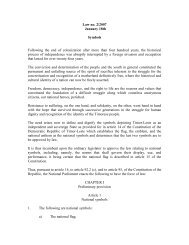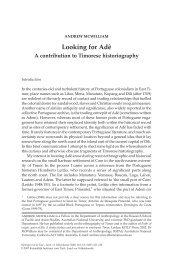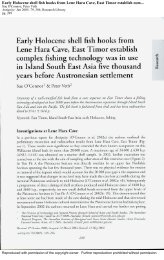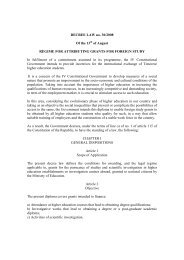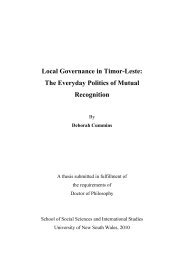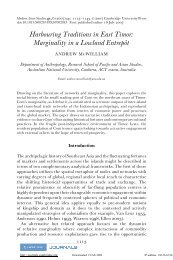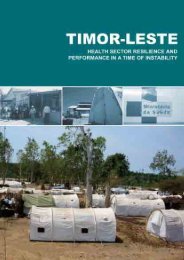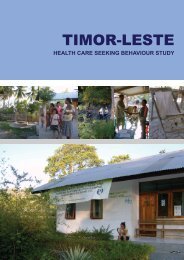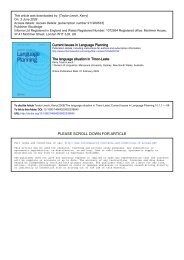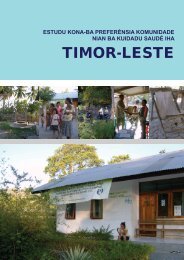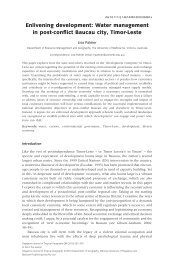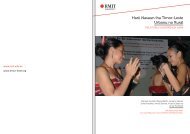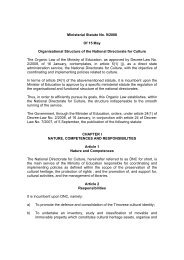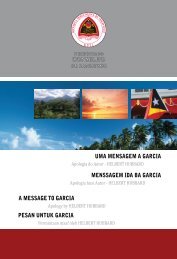The Naueti relationship terminology - Secretaria de Estado da Arte e ...
The Naueti relationship terminology - Secretaria de Estado da Arte e ...
The Naueti relationship terminology - Secretaria de Estado da Arte e ...
Create successful ePaper yourself
Turn your PDF publications into a flip-book with our unique Google optimized e-Paper software.
258<br />
David Hicks<br />
tracts the alliances) varies according to circumstance. Sometimes lineages serve<br />
as the alliance groups; on other occasions it is segments of a lineage that carry<br />
out this function. As in systems of asymmetric alliance <strong>de</strong>scribed elsewhere in<br />
Timor (Clamagirand 1987; Cunningham 1967; Hicks 1983), in the <strong>Naueti</strong> barlaque<br />
the alliance groups and the symbolic i<strong>de</strong>ntity of the prestations received<br />
are consistent. <strong>The</strong> bri<strong>de</strong>wealth is consi<strong>de</strong>red masculine and the wife-giving<br />
alliance group is classified as masculine; the counter-prestations are consi<strong>de</strong>red<br />
feminine and the wife-taking alliance group is classified as feminine.<br />
<strong>The</strong> bri<strong>de</strong>wealth (otaweli) 27 consists of horses (ku<strong>da</strong>), buffaloes (karau), goats<br />
(bibi), chickens (manu), gol<strong>de</strong>n pectoral plates (belak) worn by men, war swords<br />
(surik), money (osan), and gold (osan mea). In addition to the pre-eminent gift of<br />
the person of the bri<strong>de</strong> herself, the counter-prestations (kesakai) consist of cloth<br />
(tais), pigs (fahi), rice (fos), and coral necklaces (barae) worn by women. <strong>The</strong><br />
components of both sets of prestations are unequal in prestige. In the otaweli<br />
the prime gifts are the horse and buffalo, with the belak and surik ranking below<br />
them, and the goats and chickens still further below. In the kesakai the barae<br />
rank at the bottom of the prestige chain. With its ever-increasing acceptance in<br />
<strong>Naueti</strong> society to<strong>da</strong>y, money can substitute for the animals and the barae.<br />
Conclusions<br />
<strong>The</strong> above analysis has established that the <strong>Naueti</strong> practise asymmetric alliance<br />
as an institution and classify kin and affines according to a <strong>relationship</strong><br />
<strong>terminology</strong> of asymmetric prescriptive alliance. This finding leads to certain<br />
conclusions that have relevance for the comparative study of <strong>relationship</strong> systems<br />
in eastern Indonesia. In the study of Timorese <strong>relationship</strong> terminologies<br />
(Hicks 1990) to which I allu<strong>de</strong>d in my opening remarks, I attempted to<br />
<strong>de</strong>monstrate how certain terminologies in the region of Timor might have<br />
evolved, specifically arguing that on the basis of the <strong>da</strong>ta available at that time<br />
one feasible evolutionary progression might be construed to be as follows:<br />
Symmetric prescriptive <strong>terminology</strong> with exogamous moieties (no instance in Indonesia)<br />
→ symmetric prescriptive <strong>terminology</strong> with no moieties (Atoni (patrilineal),<br />
Northern Tetum (matrilineal)) → transitional <strong>terminology</strong> (Mbae of western<br />
Flores (predominately symmetric), Kairui (predominately symmetric), Makassai<br />
(predominately asymmetric)) → asymmetric prescriptive <strong>terminology</strong> (Ema, Ké<strong>da</strong>ng<br />
(no asymmetric alliances), 28 Mambai, Lamaholot, Western Manggarai) →<br />
non-prescriptive, but lineal (ViquequeTetum) → non-lineal (Bunak). 29<br />
27 <strong>The</strong> term most generally used throughout East Timor is folin, a word borrowed from the<br />
Tetum language.<br />
28 A population located on the island of Lomblen, eastern Indonesia (Barnes 1974).<br />
29 <strong>The</strong> Lamaholot-speaking people are found in eastern Flores and on adjacent islands in the<br />
archipelago, including Solor.



